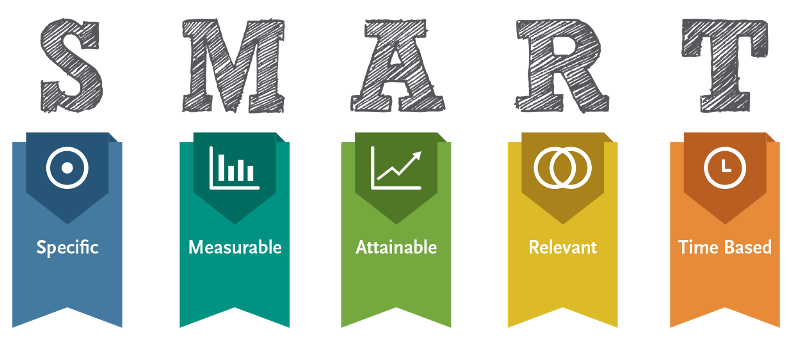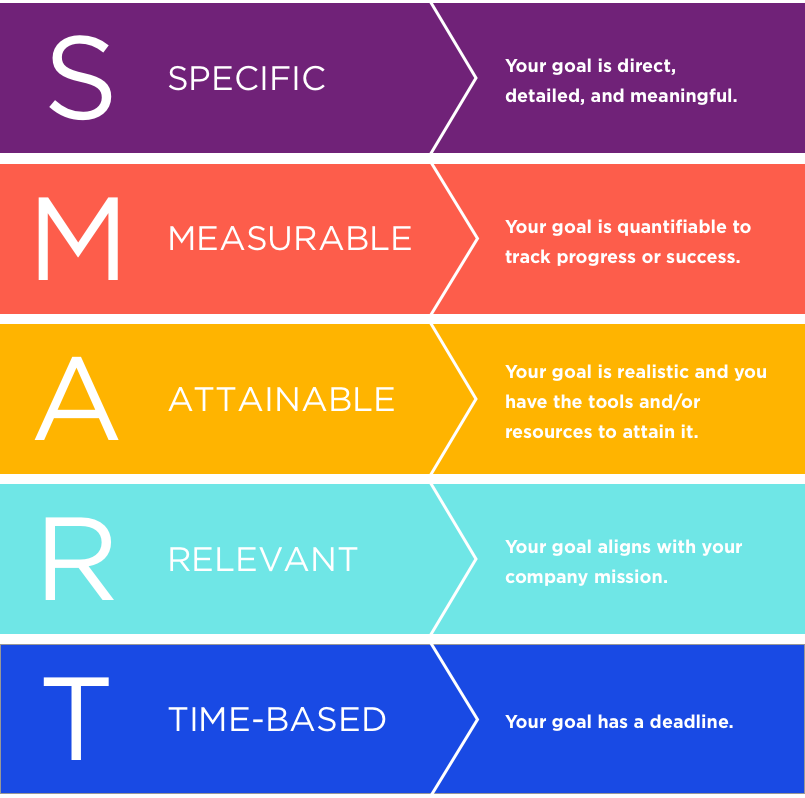
SETTING YOUR SMART GOALS FOR THIS YEAR

In both business and personal affairs, it’s scientifically proven that setting clear and actionable goals increases your chances of growing or making meaningful changes.
Many businesses feel as if they’re adrift in the world. They work hard, but they don’t seem to get anywhere worthwhile. A key reason that they feel this way is that they haven’t spent enough time thinking about what they want from life, and haven’t set themselves formal goals. After all, would you set out on a major journey with no real idea of your destination? Probably not!
But what does that really mean? Remember, it doesn’t have to be New Year’s Eve to make a change or decide to do something in your business (or your life) differently. The best time to set and assess your goals and milestones is right now.
The reality is, most people’s New Year’s resolutions are completely out the window before the end of January, which warrants the question: What is going wrong? Why aren’t people following through on their resolutions? What can that tell us about how to set better goals all year long?
How to Set a Goal
First consider what you want to achieve, and then commit to it. Set SMART (specific, measurable, attainable, relevant and time-bound) goals that motivate you and write them down to make them feel tangible. Then plan the steps you must take to realize your goal, and cross off each one as you work through them.
Goal setting is a powerful process for thinking about your ideal future, and for motivating yourself to turn your vision of this future into reality.
The process of setting goals helps you choose where you want to go in life. By knowing precisely what you want to achieve, you know what to concentrate your efforts on. You’ll also quickly spot the distractions that can, so easily, lead you astray.

Why Set Goals? Top-level athletes, successful businesspeople and achievers in all fields all set goals. Setting goals gives you long-term vision and short-term motivation. It focuses your acquisition of knowledge, and helps you to organize your time and your resources so that you can make the most of your life
By setting sharp, clearly defined goals, you can measure and take pride in the achievement of those goals, and you’ll see forward progress in what might previously have seemed a long pointless grind. You will also raise your self-confidence , as you recognize your own ability and competence in achieving the goals that you’ve set.
Common issues to avoid when setting goals
If you’re struggling to achieve your goals, don’t throw in the towel just yet. Start by addressing what has caused you to fall short in the past. Here are a few common pitfalls that you may have experienced when setting business goals.
Setting goals with no clear direction
We often set goals—whether it be in our personal or business lives—without thinking about why we’re doing it in the first place. “I’m going to get fit” or “I want to make more money” or “I want to double our sales in the first quarter of 2021″—If this sounds like you, you’re not alone.
The problem is that these types of statements are just that—statements that have little meaning, no reasoning, and that lack specificity. This is why it’s important to consider a series of objectives before attempting to reach that elusive goal.
A great example of a business that set goals with a clear direction is All Interiors, because they gained their invaluable experience by working within the Interior Décor and Interior Design industry from the ground up, giving them the tools of understanding the fundamentals of curtain making, soft furnishing and furniture manufacture as well as procurement and project management.
Setting unrealistic goals
There are many reasons people don’t stick to their goals. But the main reason is that people simply set the bar too high. Resolutions like “lose 50 pounds in two weeks” are unattainable, and people give up on their goal completely when results aren’t showing fast enough.
In business, this is similar to earning $10K one year and expecting to have a 1,000 percent increase in revenue, when in reality there will probably only be a 10 to 15 percent increase (if nothing exponential has changed in your business). You need to create realistic expectations for yourself and your business.
Lacking motivation
It’s important to recognize what you perceive as “success,” and to make note of your attitude toward failure. Research shows that highly successful people have a strong motive to achieve, whereas their less successful counterparts focus on avoiding failure.
Do you tend to blame external factors when you don’t succeed? Or do you take responsibility, persevere, and view setbacks as an opportunity for growth?
If you’re constantly giving up after every setback, you’ll never achieve the goals you set. This is why it’s vital to have milestones, metrics, or other ways of measuring success to help you navigate failure or missteps. On this note its fair to mention that Imsyser is one company that is motivated on SA Businesses. They are also very active on the SA Businesses Market Place. The new kid on the block CRAWL is very active as well and gaining potential
What are SMART Goals?
Smart is simply an acronym that represents steps for goal setting. In general, your goals should be:
S – Specific (or Significant).
M – Measurable (or Meaningful).
A – Attainable (or Action-Oriented).
R – Relevant (or Rewarding).
T – Time-bound (or Trackable).
Some professionals think this should be expanded to SMARTER to include evaluated and reviewed in the process as well. While we do agree with the need to evaluate and review, this should be an active part of your business rather than a simple step when outlining goals. For more on that, check out our article on running a monthly plan review meeting.
2. Answer specific questions
To narrow in on the specifics of your goals, you need to walk yourself through these five questions.
What do I want to accomplish?
Why is this goal important?
Who is involved?
Where is it located?
Which resources will be involved?
By answering these questions, you can quickly identify if a goal is relevant to your business, and if it will truly accomplish what you expect it to. You’ll also allocate resources and team members in this stage, setting clear parameters for how it will be accomplished and who will lead the process.
3. Set performance indicators
Knowing why you’re pursuing a goal, what you hope to accomplish, and what resources will be involved isn’t enough. You also need to determine what success looks like by establishing performance indicators to help track your process.
You should hope to answer questions such as:
What is our required return on investment?
How many additional sales or sign-ups do we need?
How do we know when the goal is accomplished?
These measurements may include both data-driven indicators as well as actionable steps that must be taken. By tracking results, you can quickly identify if you’re on the right track or if you need to pivot your goals based on poor performance. The metrics you decide to track will fully depend on your business or project, but here are a few key metrics we recommend you consider. IDEALLY Global in Cape Town is one company that is focused in achieving its goals.
4. Determine if your goal is achievable and relevant
We’ll tie these two steps in developing SMART Goals together since they both will tell you if your goal is actually possible or not.
First, you need to determine if your goal is actually possible. When originally laying out your goals, it’s worth throwing everything out there no matter how crazy the idea sounds. From there, it’s up to you to zero in on what is actually possible by determining what sort of time, monetary, and other constraints may limit your pursuits.
The other side of this is determining if you’re new goals are actually relevant to your business. Is it applicable to your current business needs? Are there other goals that should take priority? Does the time, money, and effort spent seem worthwhile?
If you answer “no” to any questions at this point, then it’s probably time to roll back to step 1 or find alternate paths for your current goal. The best thing you can do is establish OKR’s (Objectives and Key Results) for your business that act as a guiding light for what’s important. The great thing is that you can actually walk through this same process to set those larger goals, but having them established will help make any future goal-setting decisions that much easier. Jade Photography is one such company that has achievable goals. For all your photographic events they are the people to contact.

5. Set a schedule
The last thing you need to do is set a target date to complete your goals. This is meant to help you prioritize your larger projects and goals as you deal with day-to-day actions. But it’s not enough to just set a finish date, to really give yourself a chance you need to establish milestones.
These can be moments where you review progress, expect to complete a stage of your goal, or when you need to decide on how to proceed. By setting smaller stages within your larger schedule, you’ll make sure you never lose track of your goals and can actively make decisions to help you achieve them.
We are very excited at SA Businesses because we feel that we are part of your business and we would like to help you grow and be able to achieve your set goals in 2022. The team in the office is ready to help you achieve them. A problem shared is a problem solved. Lets work together this 2022.




Leave your comment